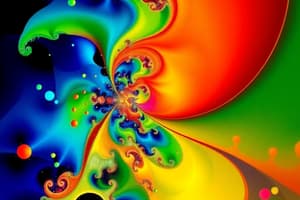Podcast
Questions and Answers
Which of the following is NOT a key application of fractal geometry?
Which of the following is NOT a key application of fractal geometry?
- Computer Graphics
- Financial Modeling
- Medical Imaging
- Weather Forecasting (correct)
What is a key characteristic of fractals that makes them useful in financial modeling?
What is a key characteristic of fractals that makes them useful in financial modeling?
- Their predictable and linear nature.
- Their ability to model exponential growth.
- Their simple and easily defined equations.
- Their self-similar structures. (correct)
How do fractals contribute to medical imaging?
How do fractals contribute to medical imaging?
- They provide a way to identify specific types of cells.
- They allow for the creation of 3D models of organs and tissues.
- They allow for real-time monitoring of blood flow.
- They help to measure the complexity of structures like blood vessels. (correct)
What is the fundamental basis for constructing many fractals?
What is the fundamental basis for constructing many fractals?
What makes the application of fractals in financial modeling challenging?
What makes the application of fractals in financial modeling challenging?
Which of the following is not a defining characteristic of fractals?
Which of the following is not a defining characteristic of fractals?
What does the concept of "fractional dimension" imply about fractals?
What does the concept of "fractional dimension" imply about fractals?
Which of these is not an example of a fractal?
Which of these is not an example of a fractal?
What happens to the perimeter and area of the Koch Snowflake as it is iteratively constructed?
What happens to the perimeter and area of the Koch Snowflake as it is iteratively constructed?
How are fractals relevant to image compression?
How are fractals relevant to image compression?
Which of these natural phenomena could be modeled using fractal structures?
Which of these natural phenomena could be modeled using fractal structures?
What is the fundamental concept behind the application of fractals in numerical analysis and simulations?
What is the fundamental concept behind the application of fractals in numerical analysis and simulations?
Which of these is not a characteristic of how fractals are used in modeling natural phenomena?
Which of these is not a characteristic of how fractals are used in modeling natural phenomena?
Flashcards
Fractals in Graphics
Fractals in Graphics
Fractals are used to create complex and realistic shapes in computer graphics.
Fractal Geometry in Finance
Fractal Geometry in Finance
Fractal geometry analyzes financial market patterns and stock price volatility.
Self-Similar Structures
Self-Similar Structures
Fractals exhibit repeating patterns at different scales, known as self-similarity.
Complexity in Medical Imaging
Complexity in Medical Imaging
Signup and view all the flashcards
Recurrence Relations
Recurrence Relations
Signup and view all the flashcards
Fractals
Fractals
Signup and view all the flashcards
Self-similarity
Self-similarity
Signup and view all the flashcards
Fractional Dimension
Fractional Dimension
Signup and view all the flashcards
Recursion
Recursion
Signup and view all the flashcards
Irregularity
Irregularity
Signup and view all the flashcards
Mandelbrot Set
Mandelbrot Set
Signup and view all the flashcards
Sierpinski Triangle
Sierpinski Triangle
Signup and view all the flashcards
Applications of Fractals
Applications of Fractals
Signup and view all the flashcards
Study Notes
Fractals
- Fractals are complex geometric shapes that exhibit self-similarity at different scales. Parts of the fractal look like the whole, or are scaled-down versions of the whole.
Defining Characteristics
- Self-similarity: A hallmark of fractals. Zooming in on a portion of the fractal reveals resemblance to the overall shape.
- Fractional Dimension: Many fractals have dimensions that are not whole numbers, meaning their measure transcends typical 1D, 2D, or 3D spaces, defying conventional geometric concepts.
- Recursion: Fractals are often generated by a recursive process, where the same mathematical rule(s) are repeatedly applied to progressively smaller parts of the shape, leading to increasingly complex detail.
- Irregularity: Fractals are irregular and complex shapes, differing from smooth, regular geometric forms.
Examples of Fractals and Their Properties
- Mandelbrot Set: A famous fractal in the complex plane, showcasing self-similarity across various scales, with distinct color ranges highlighting the patterns.
- Sierpinski Triangle: A fractal composed of recursively removed triangles, forming a repeating pattern.
- Koch Snowflake: Constructed by repeatedly replacing line segments with smaller segments forming outward curves. Each iteration increases the perimeter's complexity and length, while the enclosed area increases at a slower rate.
Applications of Fractals
- Modeling Natural Phenomena: Fractal structures appear in nature, modeling tree branching, coastlines, riverbeds, blood vessels, galactic distributions, and the human brain.
- Image Compression: Fractal-based algorithms often yield high image compression ratios by exploiting self-similarity to aggregate similar details.
- Numerical Analysis and Simulation: Fractals are used in numerical methods and simulations, particularly for complex systems exhibiting self-similarity.
- Computer Graphics: Fractal iterative nature generates complex and realistic shapes, valuable in computer graphics.
- Financial Modeling: Fractal geometry can be used in financial markets to model stock volatility and identify patterns, although its application is not universal due to market complexities and changing factors. This method can show repeating formations, even in chaotic environments.
- Medical Imaging: Fractals help measure the complexity of structures like blood vessels or tumors, potentially aiding in diagnosis and treatment.
Mathematical Background
- Fractal geometry involves fractional order equations and iterative functions, enabling rigorous definitions of these complex shapes and their properties.
- Recurrence relations and functions are fundamental to fractal constructions, producing complex structures through iterative applications of a mathematical recipe.
Studying That Suits You
Use AI to generate personalized quizzes and flashcards to suit your learning preferences.





